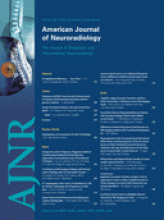Abstract
BACKGROUND AND PURPOSE: To use MR spectroscopy to aid in the diagnosis of demyelinating disease and to help differentiate tumefactive demyelinating lesions from neoplastic processes.
MATERIALS AND METHODS: MR imaging of the brain was obtained in 4 patients who presented clinically with focal neurologic deficits. MR imaging initially revealed parenchymal mass lesions. Single-voxel MR spectroscopy was then performed utilizing a point-resolved spectroscopy sequence protocol with a short echo time (30 msec).
RESULTS: MR imaging revealed a focal ring-enhancing mass in one patient, multiple ring-enhancing lesions in the second patient, a large area of edema and mass effect without associated enhancement in the third patient, and multiple solid and peripherally enhancing lesions in the fourth patient. MR spectroscopic results in all 4 patients demonstrated marked elevation of the glutamate and glutamine peaks (2.1–2.5 ppm). Other nonspecific (and in a sense confounding) findings included elevation of the choline peak (3.2 ppm), elevation of the lactate peak (1.3 ppm), elevation of the lipid peak (0.5–1.5 ppm), and decrease in the N-acetylaspartate peak (2.0 ppm). All 4 patients were eventually given the diagnosis of multiple sclerosis based on CSF analysis, brain biopsy, and/or clinical follow-up.
CONCLUSION: MR spectroscopic metabolite information may be useful in the diagnosis of demyelinating disease by demonstrating elevation of the glutamate/glutamine peaks because elevation of these peaks is typically not seen in aggressive intra-axial neoplastic processes. This is particularly beneficial in the rarer cases of tumefactive demyelinating lesions, which are very difficult to differentiate from neoplasms by imaging findings alone.
- Copyright © American Society of Neuroradiology












